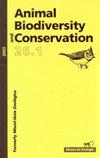最北端美洲豹繁殖种群的丰度
IF 1
4区 环境科学与生态学
Q3 BIODIVERSITY CONSERVATION
引用次数: 0
摘要
美洲虎是美洲热带和亚热带生态系统的顶级掠食者,但由于栖息地丧失、偷猎和捕食冲突,美洲虎的保护受到威胁。北部美洲虎保护区(NJR)是由 Naturalia A.C. 创建的一个项目,旨在保护占地 5.93 万英亩(24.4 公顷)的私人领地内最北部的美洲虎种群。该保护区还包括其他受保护物种。本研究旨在核实该美洲虎种群的状况,以评估 NJR 的有效性,并增进对其生态学的了解。我们使用标记-观察和空间明确捕获-再捕获(SERC)模型估算了美洲虎的密度,并通过在 12 个双月期间设置 56 个照相机捕捉站进行调查,评估了美洲虎的活动范围。我们总共进行了 40,880 个照相日的取样工作,每 1,000 个照相日记录了 2.32 条记录。使用捕获-再捕获模型计算的美洲虎密度介于 0.3 至 1.44 indiv./100 km2 之间,而 SERC 模型估计的密度介于 0.21 至 3.04 indiv./100 km2 之间。雄性的家园范围为 78.9 平方公里,雌性为 45.1 平方公里。对美洲虎种群进行长期监测,同时建立自愿指定保护区(墨西哥政府最近提出的一项倡议),如墨西哥西北部保护区(NJR),可作为加强美洲虎保护的有效战略,从而维护墨西哥西北部其他物种及其栖息地的关键生态过程。本文章由计算机程序翻译,如有差异,请以英文原文为准。
Abundance of the northernmost jaguar Panthera onca breeding population
Jaguars are the apex predators of tropical and subtropical ecosystems in the Americas but their conservation is threatened due to habitat loss, poaching, and conflicts over predation. The Northern Jaguar Reserve (NJR) was created by Naturalia A.C. as a project to protect the northernmost jaguar population within an area of 59.3 thousand acres (24.4 ha) of private property. The property also includes other protected species. The present study was conducted to verify the status of this jaguar population in order to evaluate the effectiveness of the NJR, and to contribute to knowledge regarding its ecology. We estimated density using mark-resight and spatially explicit capture-recapture (SERC) models, and evaluated home range through a survey with 56 camera-trap stations over 12 bimonthly periods. In total, we obtained a sampling effort of 40,880 camera-days, registering 2.32 records from 1,000 camera-days. Jaguar density, calculated using the capture-recapture models, ranged from 0.3 to 1.44 indiv./100 km2, while the SERC model estimated a density of between 0.21 and 3.04 indiv./100 km2. The home range was 78.9 km2 for males and 45.1 km2 for females. Long-term population monitoring together with the establishment of Areas Voluntarily Assigned to Conservation, an initiative recently created by the Mexican government, such as the NJR, could be a valid strategy to strengthen jaguar conservation and thereby maintain key ecological processes for other species and their habitat in northwestern Mexico.
求助全文
通过发布文献求助,成功后即可免费获取论文全文。
去求助
来源期刊

Animal Biodiversity and Conservation
农林科学-动物学
CiteScore
2.00
自引率
0.00%
发文量
21
审稿时长
>12 weeks
期刊介绍:
Animal Biodiversity and Conservation (antes Miscel·lània Zoològica) es una revista interdisciplinar, publicada desde 1958 por el Museu de Ciències Naturals de Barcelona. Incluye artículos de investigación empírica y teórica en todas las áreas de la zoología (sistemática, taxonomía, morfología, biogeografía, ecología, etología, fisiología y genética) procedentes de todas las regiones del mundo. La revista presta especial interés a los estudios que planteen un problema nuevo o introduzcan un tema nuevo, con hipòtesis y prediccions claras, y a los trabajos que de una manera u otra tengan relevancia en la biología de la conservación. No se publicaran artículos puramente descriptivos, o artículos faunísticos o corológicos en los que se describa la distribución en el espacio o en el tiempo de los organismes zoológicos.
 求助内容:
求助内容: 应助结果提醒方式:
应助结果提醒方式:


